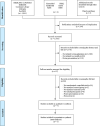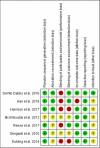Effectiveness of eHealth interventions for improving medication adherence of organ transplant patients: A systematic review and meta-analysis
- PMID: 33152010
- PMCID: PMC7644069
- DOI: 10.1371/journal.pone.0241857
Effectiveness of eHealth interventions for improving medication adherence of organ transplant patients: A systematic review and meta-analysis
Abstract
Background: Organ transplantation is the most effective treatment for patients with end-stage organ failure. It has been actively carried out all over the world. Recently, eHealth interventions have been applied to organ transplant patients. This systematic review and meta-analysis aimed to evaluate the effects of eHealth interventions for improving medication adherence in organ transplant patients as compared to usual or conventional care alone.
Methods: We searched MEDLINE via PubMed, Excerpta Media dataBASE (EMBASE), the Cochrane Register Controlled Trials, the Cumulative Index to Nursing and Allied Health Literature (CINAHL), PsycINFO, and six domestic Korean databases to identify randomized controlled trials (RCTs) published up to April 17, 2020. Two reviewers independently selected relevant studies and extracted data. The quality and bias of the identified studies were assessed. To estimate the effect size, a meta-analysis of the studies was performed using the Cochrane Collaboration software Review Manager 5.3. PRISMA guidelines were followed. When statistical heterogeneity was greater than 80%, narrative synthesis was performed.
Results: Of the 1,847 articles identified, seven RCTs with a total of 759 participants met the inclusion criteria. The risk of bias assessment showed that the blinding of participants and personnel was high. In six studies, medication adherence (effect size = -0.18-1.30) and knowledge scores were not significantly different between those receiving eHealth interventions and the controls.
Conclusions: Our findings suggest that eHealth interventions were similar to standard care or advanced care for improving medication adherence, and they faired equally well for improving medication knowledge. Therefore, eHealth interventions can be used for medication adherence of organ transplant patients. More research is needed to provide well-designed eHealth intervention to improve the medication adherence and knowledge of organ transplant patients.
Protocol registration number: CRD42017067145 16/05/2017.
Conflict of interest statement
The authors have declared that no competing interests exist.
Figures






Similar articles
-
Effectiveness of eHealth for Medication Adherence in Renal Transplant Recipients: Systematic Review and Meta-Analysis.J Med Internet Res. 2025 May 13;27:e73520. doi: 10.2196/73520. J Med Internet Res. 2025. PMID: 40359506 Free PMC article. Review.
-
Effect of Interactive eHealth Interventions on Improving Medication Adherence in Adults With Long-Term Medication: Systematic Review.J Med Internet Res. 2021 Jan 8;23(1):e18901. doi: 10.2196/18901. J Med Internet Res. 2021. PMID: 33416501 Free PMC article.
-
eHealth interventions for people with chronic kidney disease.Cochrane Database Syst Rev. 2019 Aug 6;8(8):CD012379. doi: 10.1002/14651858.CD012379.pub2. Cochrane Database Syst Rev. 2019. PMID: 31425608 Free PMC article.
-
The Use and Effects of Electronic Health Tools for Patient Self-Monitoring and Reporting of Outcomes Following Medication Use: Systematic Review.J Med Internet Res. 2018 Dec 18;20(12):e294. doi: 10.2196/jmir.9284. J Med Internet Res. 2018. PMID: 30563822 Free PMC article.
-
Effect of eHealth Interventions on Medication Adherence in Kidney Transplant Recipients: Meta-Analysis of Randomised Controlled Trials.J Ren Care. 2025 Jun;51(2):e70015. doi: 10.1111/jorc.70015. J Ren Care. 2025. PMID: 40196913
Cited by
-
Self-Management Using eHealth Technologies for Liver Transplant Recipients: Scoping Review.J Med Internet Res. 2024 Jul 4;26:e56664. doi: 10.2196/56664. J Med Internet Res. 2024. PMID: 38963937 Free PMC article.
-
Evaluation of the use of a Renal Health application by kidney transplant recipients.Rev Lat Am Enfermagem. 2023 Jan-Dec;31:e3822. doi: 10.1590/1518-8345.6039.3822. Rev Lat Am Enfermagem. 2023. PMID: 36722638 Free PMC article.
-
Psychosocial Diagnosis and Treatment Before and After Organ Transplantation.Dtsch Arztebl Int. 2023 Jun 16;120(24):413-416. doi: 10.3238/arztebl.m2023.0087. Dtsch Arztebl Int. 2023. PMID: 37101343 Free PMC article.
-
Effectiveness of eHealth for Medication Adherence in Renal Transplant Recipients: Systematic Review and Meta-Analysis.J Med Internet Res. 2025 May 13;27:e73520. doi: 10.2196/73520. J Med Internet Res. 2025. PMID: 40359506 Free PMC article. Review.
References
-
- United Network for Organ Sharing [Internet]. Richmond (VA): Onus: Transplant Trends; c2019 [cited 2019 Aug 28]. Available from: https://unos.org/data/transplant-trends/.
-
- Korean Network for Organ Sharing [Internet]. Seoul: KONOS: Statistics; c2014 [cited 2019 Aug 28]. Available from: https://www.konos.go.kr
-
- van Sandwijk MS, Bemelman FJ, Ten Berge IJ. Immunosuppressive drugs after solid organ transplantation. Neth J Med. 2013;71(6):281–9. - PubMed
Publication types
MeSH terms
LinkOut - more resources
Full Text Sources
Medical
Miscellaneous

